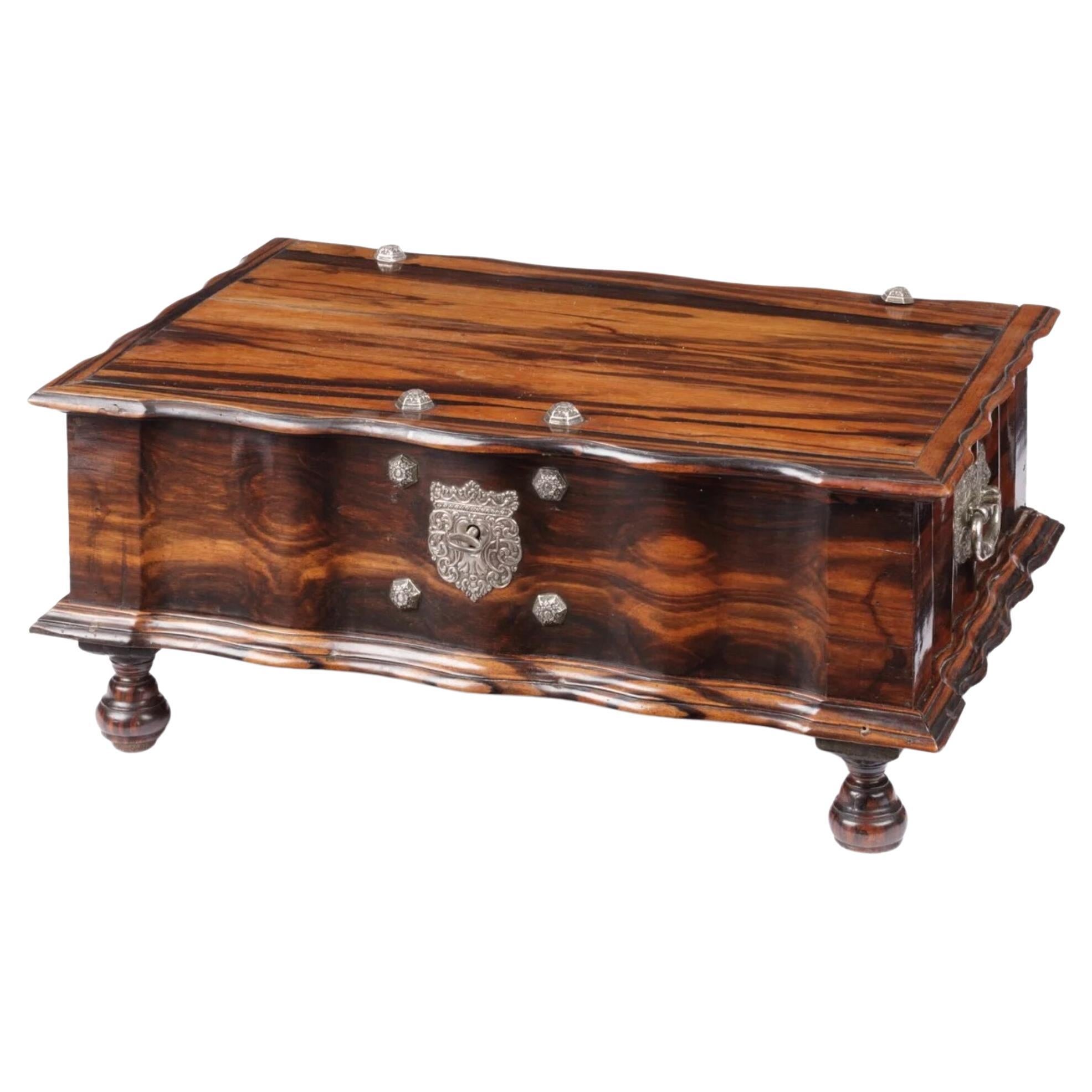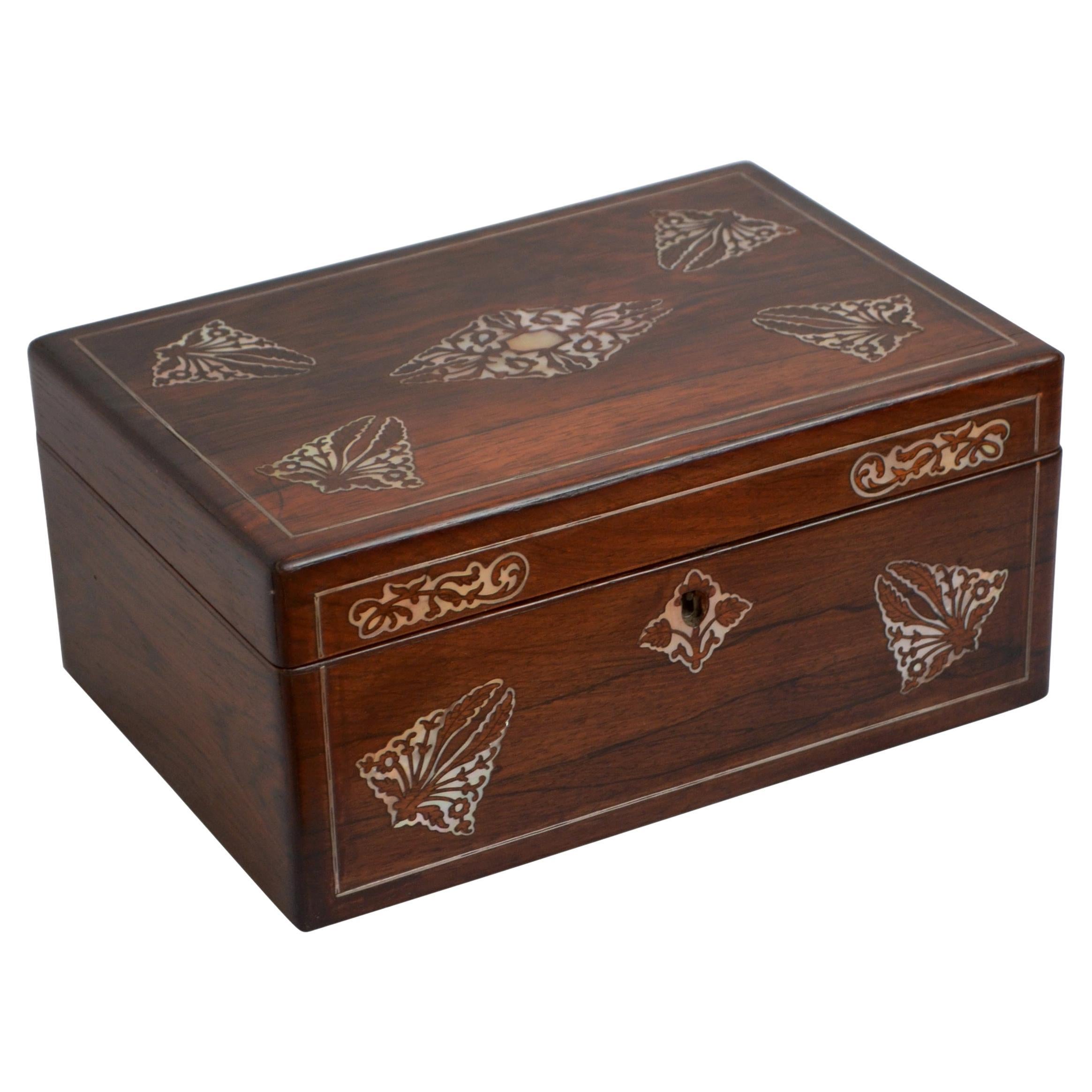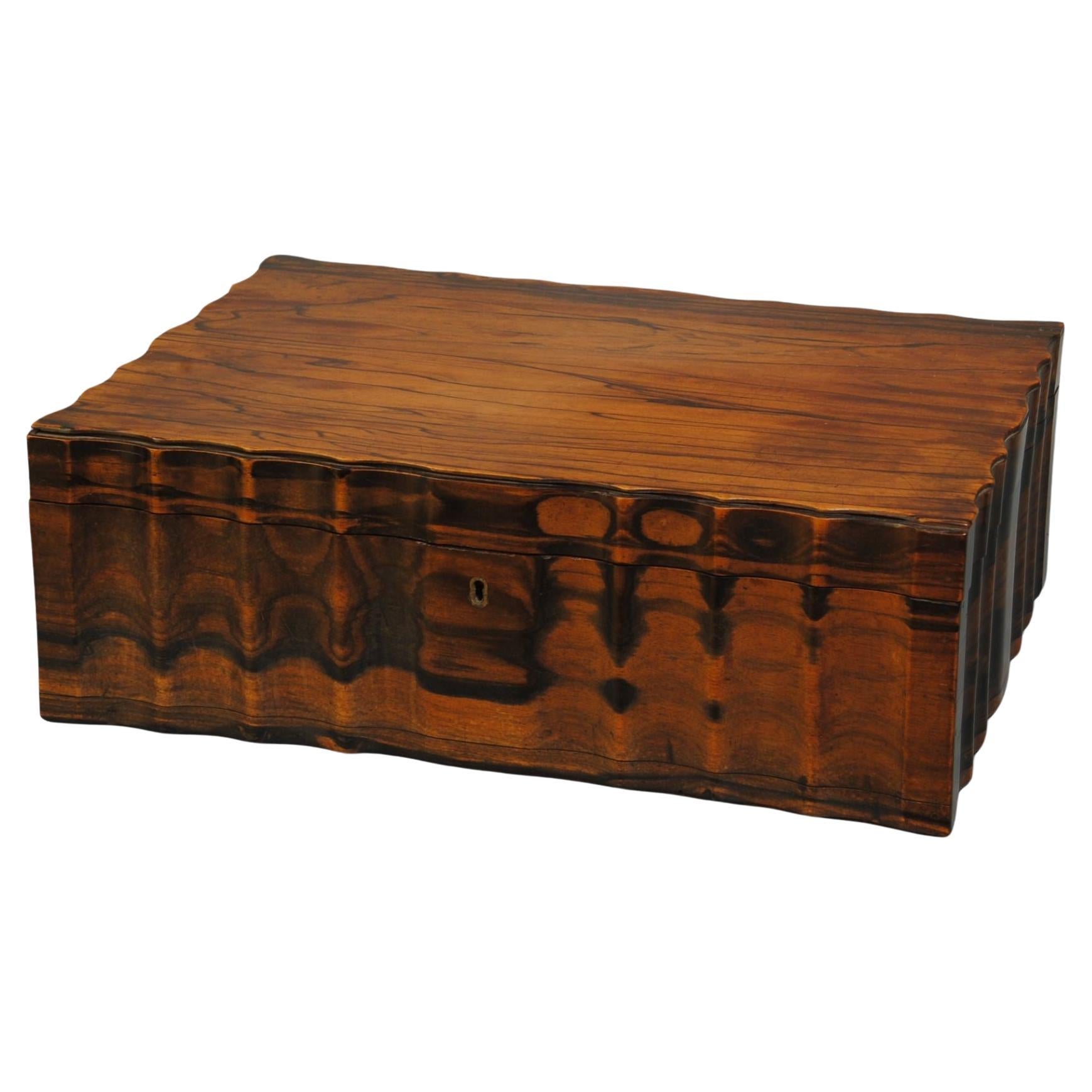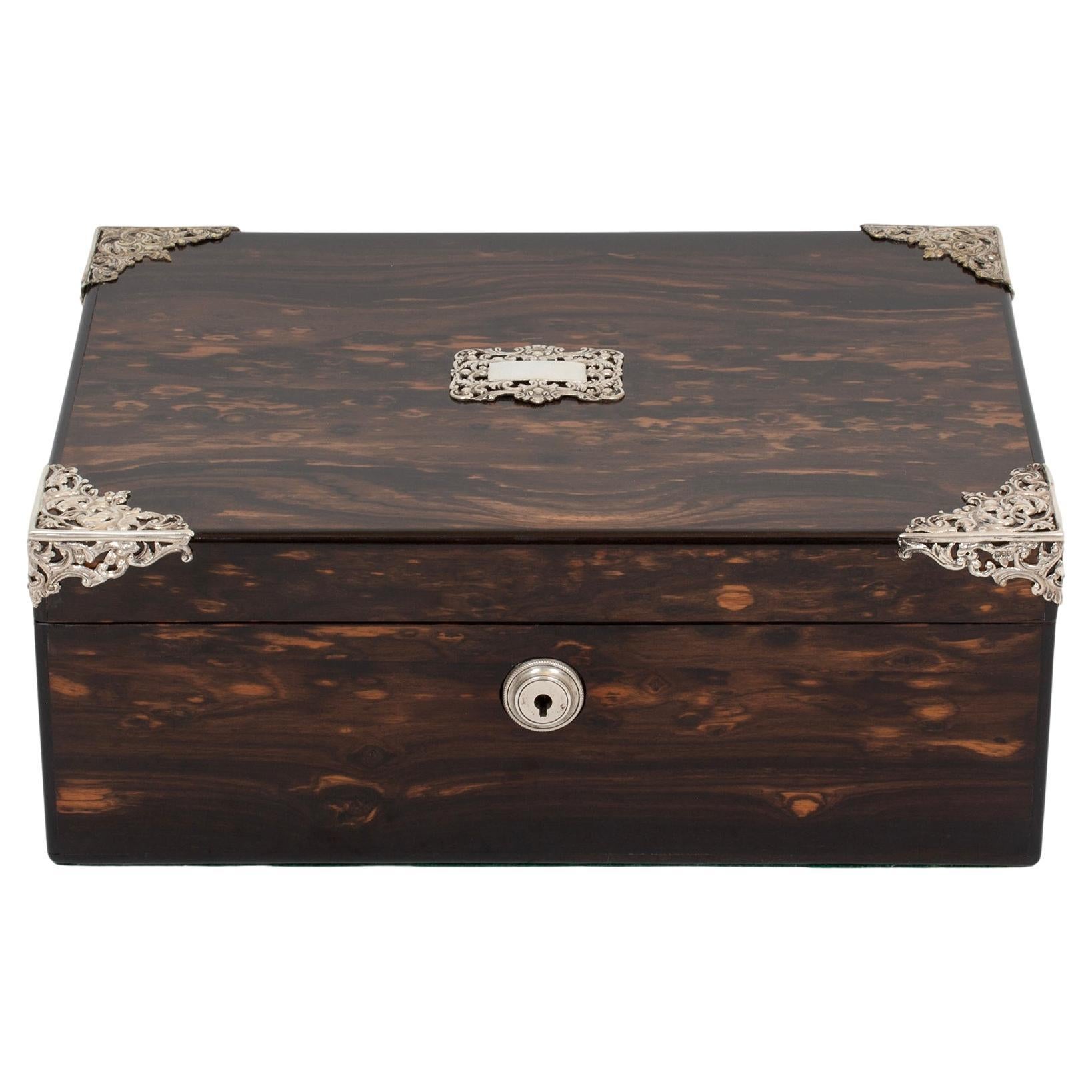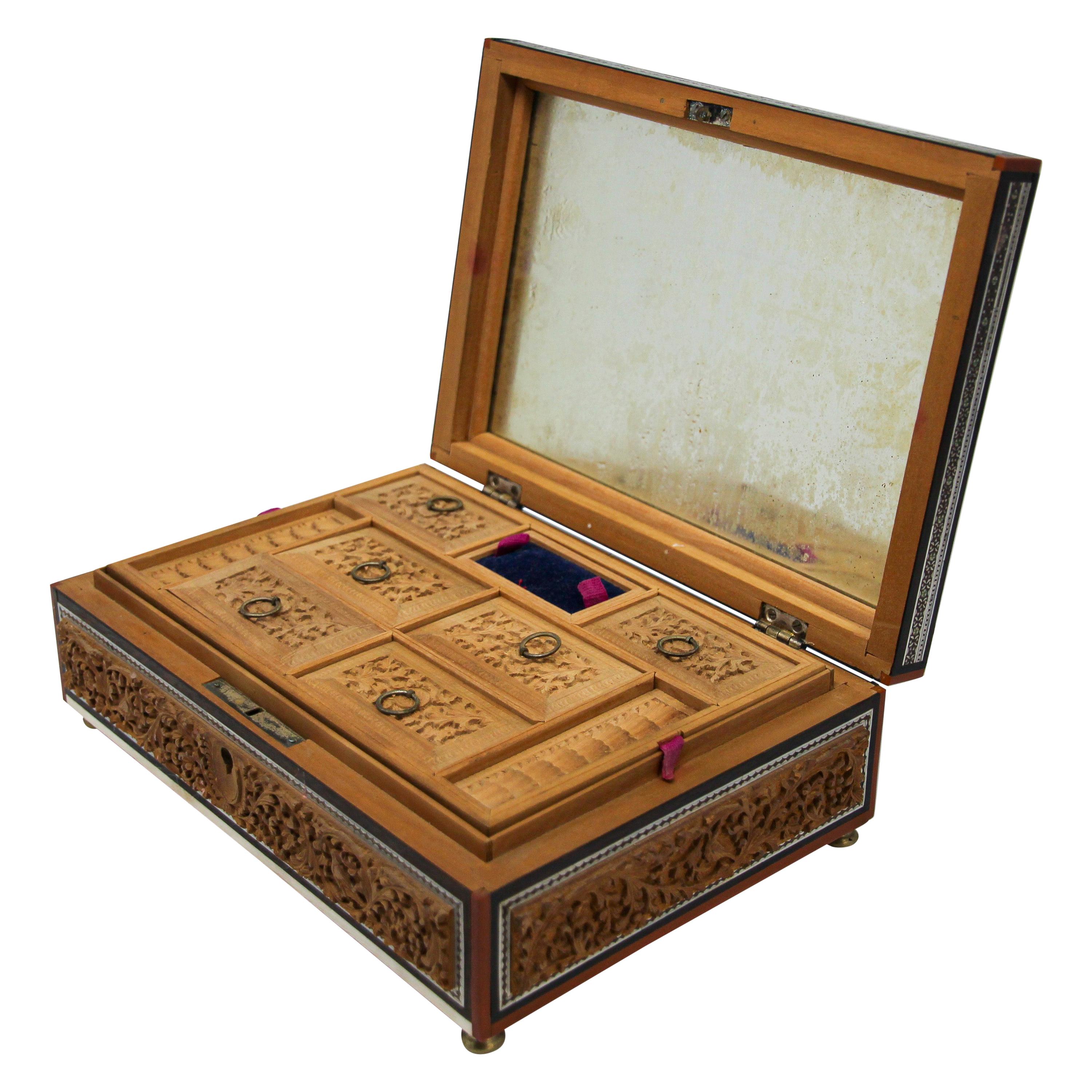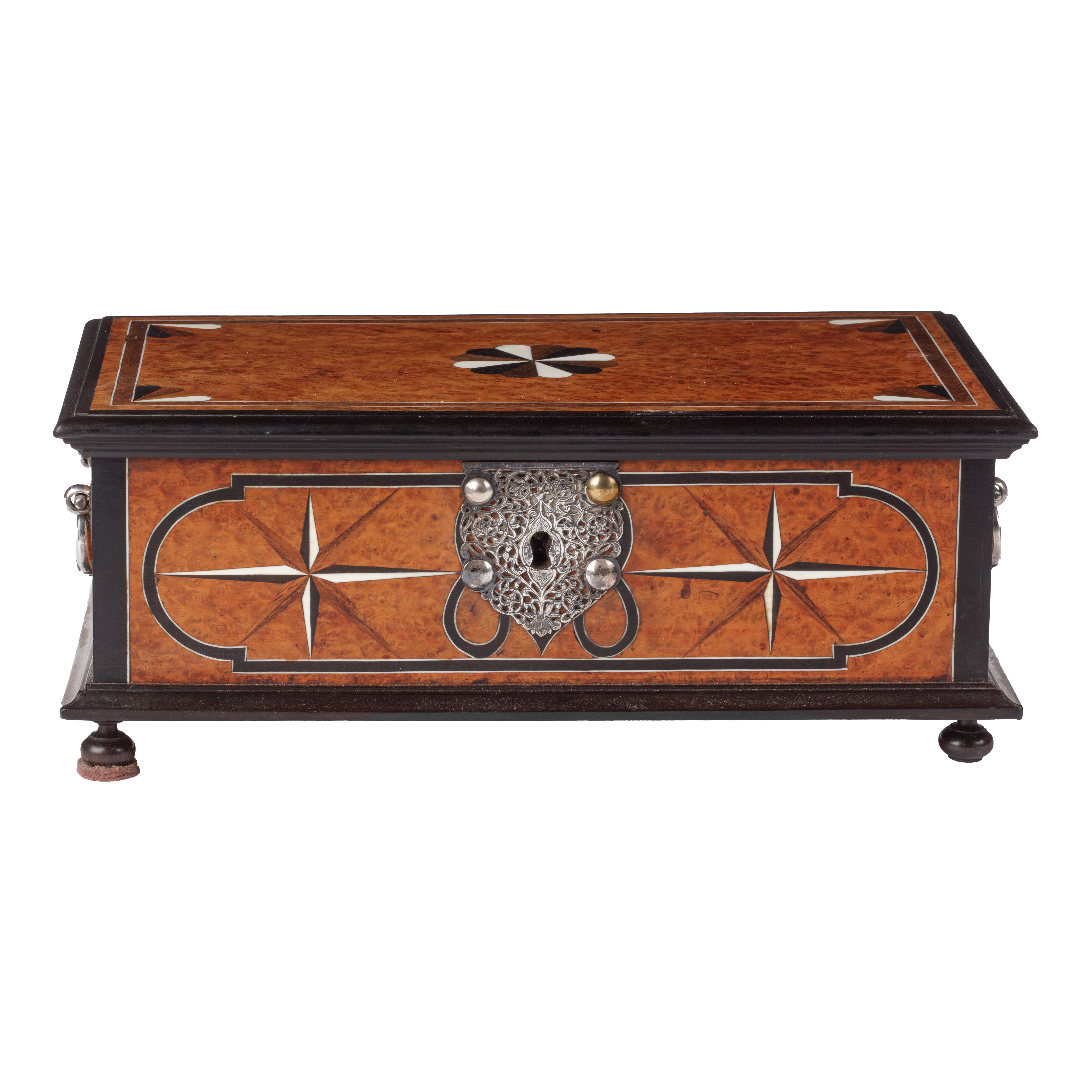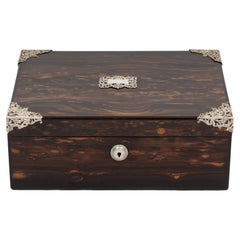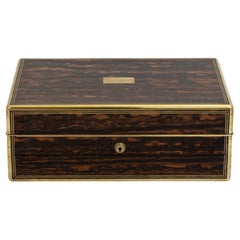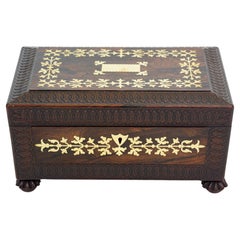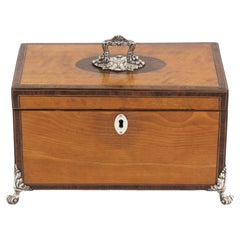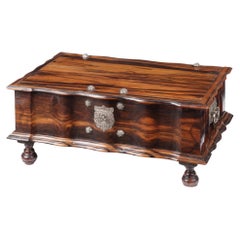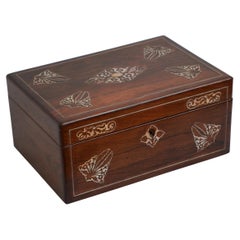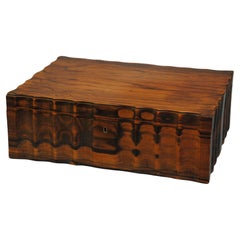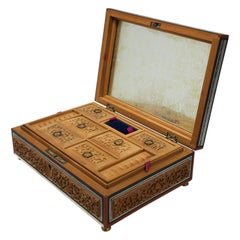Items Similar to Anglo Indian Coromandel and Silver Sewing Box
Want more images or videos?
Request additional images or videos from the seller
1 of 17
Anglo Indian Coromandel and Silver Sewing Box
$2,606.36
£1,900
€2,225.87
CA$3,660.76
A$4,030.23
CHF 2,059.86
MX$48,101.84
NOK 26,226.38
SEK 24,542.05
DKK 16,625.95
About the Item
Mounted with Silver
From our Sewing Box collection, we are pleased to offer this Solid Coromandel Anglo Indian and Silver Sewing Box. The Sewing Box of sarcophagus shape made from figured coromandel with Silver mount stood upon four fluted shell feet. The Box with a silver diamond escutcheon, a looped carry handle and a single-handled drawer. When opened the Box reveals a fully fitted interior with stitched yellow silk with a partitioned tray to the body and several slip compartments to the inside of the lid. The top tray lifts out to allow access to further storage below. To the front of the Sewing Box, a drawer pulls forward to access further storage. The feet are hallmarked to the underside with barely legible marks. The box dates to the 19th century circa 1830 late Georgian period.
The Sewing Box comes complete with a working lock and tasselled key.
Anglo Indian refers to the term given to pieces made for the colonial British market. It usually encompasses British Aesthetics of subject with Indian influences such as inlay or material.
Coromandel is a valuable wood found in India, Sri Lanka and South East Asia. It has a contrasting hazel-brown colour with black grain. It is a dense, heavy wood that is so popular it has been logged to extinction over the last few hundred years. This makes Calamander pieces even more special.
Georgian, a period in British history dating from 1714-1837, the Georgian era after the Hanoverian kings George I, George II, George III and George IV.
- Dimensions:Height: 5.52 in (14 cm)Width: 9.06 in (23 cm)Depth: 6.89 in (17.5 cm)
- Style:Anglo-Indian (Of the Period)
- Materials and Techniques:
- Place of Origin:
- Period:
- Date of Manufacture:Circa 1830
- Condition:Wear consistent with age and use.
- Seller Location:Northampton, GB
- Reference Number:Seller: 501232TRCE1stDibs: LU8027239957442
About the Seller
No Reviews Yet
Vetted Professional Seller
Every seller passes strict standards for authenticity and reliability
Established in 1998
1stDibs seller since 2023
33 sales on 1stDibs
Typical response time: <1 hour
- ShippingRetrieving quote...Shipping from: Northampton, United Kingdom
- Return Policy
Authenticity Guarantee
In the unlikely event there’s an issue with an item’s authenticity, contact us within 1 year for a full refund. DetailsMoney-Back Guarantee
If your item is not as described, is damaged in transit, or does not arrive, contact us within 7 days for a full refund. Details24-Hour Cancellation
You have a 24-hour grace period in which to reconsider your purchase, with no questions asked.Vetted Professional Sellers
Our world-class sellers must adhere to strict standards for service and quality, maintaining the integrity of our listings.Price-Match Guarantee
If you find that a seller listed the same item for a lower price elsewhere, we’ll match it.Trusted Global Delivery
Our best-in-class carrier network provides specialized shipping options worldwide, including custom delivery.More From This Seller
View AllAntique English Coromandel Sterling Silver Mounted Cigar Box
By Jane Brownett 1
Located in Northampton, GB
Hallmarked Silver 1886
From our Boxes collection, we are pleased to offer this Coromandel Silver Mounted Cigar Box. The Cigar Box of rectangular shape beautifully veneered in exotic...
Category
Antique Late 19th Century English High Victorian Tobacco Accessories
Materials
Sterling Silver
Antique Victorian Calamander Jewellery Box Rare Mechanism
Located in Northampton, GB
Calamander Veneered Exterior
From our Jewellery Box collection, we are delighted to introduce this Unusual Antique Calamander Jewellery Box. Th...
Category
Antique Late 19th Century British High Victorian Jewelry Boxes
Materials
Brass
Rare Georgian Engine Turned Sewing Box
Located in Northampton, GB
Rare Engine Turned Design
The Sewing Box of slight sarcophagus shape stood upon four turned ribbed feet. The Sewing Box tapers up to the convex raised lid and features scrolling fl...
Category
Antique Early 19th Century English William IV Decorative Boxes
Materials
Brass
Georgian Silver Mounted Satinwood Tea Chest
Located in Northampton, GB
Georgian Tea Chest with Rosewood Cross Banding
From our Tea Caddy collection, we are delighted to offer this Georgian Satinwood Tea Chest. The Tea Chest of rectangular form veneered...
Category
Antique Late 18th Century English George III Tea Caddies
Materials
Silver
Antique English Rosewood Inlaid Jewellery Box
Located in Northampton, GB
Fully Partitioned Jewellery Tray
From our Jewellery Boxes collection, we are delighted to offer this Rosewood Inlaid Jewellery Box. The Jewellery Box of slim rectangular form venee...
Category
Antique Early 19th Century English Early Victorian Jewelry Boxes
Materials
Shell, Wood
Antique Victorian English Rosewood Jewellery Box
Located in Northampton, GB
Lined in Racing Green Velvet
From our Jewellery Box collection, we are pleased to offer this Antique Rosewood Jewellery Box. The Jeweller...
Category
Antique Mid-19th Century English High Victorian Jewelry Boxes
Materials
Brass
You May Also Like
Dutch-Colonial Sri Lankan Coromandel Wood Document Box with Silver Mounts
Located in Amsterdam, NL
A Dutch-colonial Sri Lankan coromandel wood document box with silver mounts
Probably Galle, 18th century
H. 19 x W. 49 x D. 33 cm
The ches...
Category
Antique 18th Century Sri Lankan Dutch Colonial Furniture
Materials
Silver
English Early Victorian Jewellery Box with Tray
Located in High Peak, GB
P080 An elegant antique early Victorian goncalo alves sewing box or jewellery box with beautifully inlaid front and hinged top enclosing new relined interior with lift up tray. This ...
Category
Antique 19th Century English Early Victorian Cigar Boxes and Humidors
Materials
Wood
A Fine Anglo Indian Coromandel Workbox
Located in Lincolnshire, GB
A fine early 19th century coromandel work box with moulded front design and fitted interior containing a super collection of sea shells.
Ivory registration number 8NEDUS4R.
Category
Antique Early 19th Century Indian Anglo-Indian Decorative Boxes
Materials
Ivory, Wood
Anglo-Indian Footed Box with Lidded Compartments, 19th Century
Located in Moreno Valley, CA
19th century Anglo-Indian wooden box fitted with various compartments finely hand carved.
The top is finely hand carved with the Taj Mahal.
The interior with removable hand carved nine-lidded compartments, the front cover has a mirror, the whole exhibiting very fine workmanship.
This fine late Victorian Anglo-Indian box from India is in great condition for it age.
A beautiful example of an Anglo-Indian fine art...
Category
Antique Late 19th Century Indian Anglo-Indian Decorative Boxes
Materials
Sandalwood
A highly refined Dutch-colonial Sri Lankan inlaid box with silver mounts
Located in Amsterdam, NL
Galle district, 18th century
The box is made of amboyna burr with inlays of ebony, bone and burr wood and has several interior compartments, all made with the utmost attention to de...
Category
Antique 18th Century Sri Lankan Decorative Boxes
Materials
Bone, Ebony, Amboyna
Anglo Chinese 19th Century Padouk Tea Caddy
Located in Bedfordshire, GB
A Rare Mid 19th Century Anglo-Chinese Padouk Wood Rectangular Tea Caddy Having Attractive Silver Plate Mounted Decoration Throughout, The Hinged Lid Enclosing Two Lidded Divisions, W...
Category
Antique Mid-19th Century Chinese Victorian Tea Caddies
Materials
Padouk
More Ways To Browse
Antique Anglo Indian Furniture
Used Sewing Furniture
Anglo Indian Hand Carved
Anglo Indian Silver
Coromandel Furniture
Indian Silver Antique
Coromandel Wood
Indian Inlay
Anglo Indian Carved Wood
Indian Carved Wood Box
Hand Carved Indian Wood Tray
Ceramic Trinket Boxes
Horn Ivory
Ivory Boxes Antique
Tramp Art Box
Antique Bentwood Box
Antique Stationery Box
Apple Box
